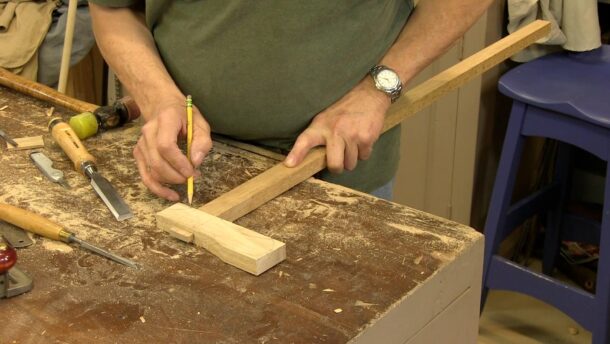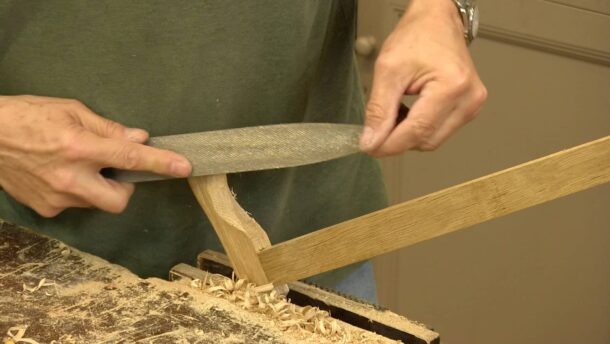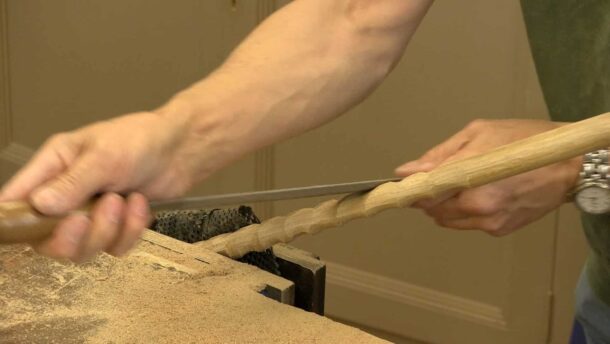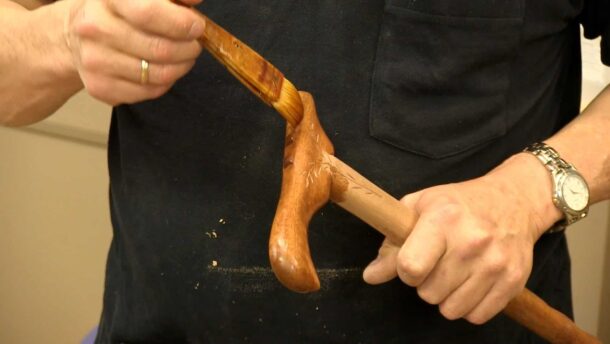Walking Cane: Project Info
Posted 28 October 2013
This is the introductory page for a paid video series. Want to watch more of this project? Select the best option below to get started.
Material dimensions:
Materials:
Paul uses oak, but you could use mahogany, ash, bois d’arc, hickory, pecan.
| Name | Size (Imperial) | Size (Metric) |
| Handle | 7″x2″x7/8″ | 180x50x22mm |
| Shaft | 38″x1 3/8″x7/8″ | 965x35x22mm |





Really looking forward to this project. The canes look fantastic.
George.
sounds great know a few people who would love these. what on earth are this types of woods paul mentioned and i am presuming they would be hard to source . did i hear that right coco bolo?
Here you go david…………..http://www.wood-database.com/lumber-identification/hardwoods/cocobolo/
What a fantastic resource Ken. Thanks for the link – it’s gone straight into my browser favourites.
interesting project guys, good job 😉
nice one ken.
Looking forward to this one. Can any ol’ hardwood be used? cherry, walnut, mahogany, maple?
Hi Jason,
Some hard woods are less appropriate for walking canes and staffs. Paul’s recommendation, as well as the oak we we use in the video, are mahogany, ash, boisdark, hickory and pecan.
Hope that helps,
Phil
What about meranti, it seems much easier to get than mahogany and I am told it is similar but I have no knowledge?
Mick
Paul, as my skills have progressed more that I could imagine – we’re also doing projects that I would have never imagined doing….
When I first started doing “woodworking” over 10 years ago, I bought Unisaw – because I thought you had to. And all I could make was Arts and Crafts (bleh), or Green and Green (double bleh), or Shaker (much better) style furniture – because that’s the only cut a table saw makes…
In those 10 years of working wood – I never would have hoped to create even a simple spoon….
I’m enternally grateful for what you’re giving to us, and to the legacy of woodoworking in general.
God bless you Paul.
It would be very nice to have a list of required (recommended) tools and materials on all project intro pages. I find those very convenient for planning acquisitions. Thanks.
– David
My back goes out so often I keep a cane in the boot of the car. Looking forward to making one I’ll keep in the front seat to show off!
Hi all,
I have just uploaded the materials and measurements info 🙂
Looking forward to see your projects photos!
ttfn, R
Thanks Resi 😉
Hi Paul,
Thanks for this great series. I was wondering hom much your basic cane would cost a customer?? Also, any advise on selling them would be of much help.
Thanks!
Joe
USA
In the USA the basic cane without twist would sell for $25-30 in oak. I think that making this can by hand would take me about 2 hours to make. The cost should be around $2 for materials in the US. If you make them by machine however, the costs drop dramatically and so too manufacture. The basic cane can be made in about 10 minutes if you set up for the whole process by machine. This is of course then becomes more a commercial venture.Mortise machine, bandsaw, router and drum sander.
Selling the canes is not too complicated. I have known two successful ways to sell canes and staffs. Make a package of say 24 canes sticks and staffs in two or three different colours. Sell them as a package. When I lived in the US I sold these packages by the hundreds to STate Parks and Wildlife Parks, gift shops and tourist centres. I also set up trade accounts with gas stations and outdoor stores like Gander Mountain. On the other hand I made 300-400 sticks for art and craft shows around the state and country. I supplied other craftspeople too, so I had several outlets and that grew quite rapidly.
In your case, there in Texas, you have the big Festivals in Austin and Texas and the Renaissance Festival too. These were good venues for me 20 years ago and I think we sold $2-4,000 in a weekend.
Paul,
Thanks for the advice. I’ve made 4 thus far and they are looking pretty good I think. I do have one question; when you said $25 to 30, was that in the 90’s or is that still a fair price currently. It’s been fun so far. I’ll let you know when I hit 24 maybe yiu could give me a tip on selling them to a person. So far, I’ve just gotten laughs. I’ll keep fighting the good fight.
Cheers
Joe
Paul, I just wanted to let you know how your “Hiking Staff” style of cane has helped my father and myself. I don’t get back to my family home in Tennessee as much as I would like. This last Thanksgiving I noticed that my father, who uses a cane, was having a lot of trouble getting out of a chair. Once I was back home in Georgia, I was picking out the next project on WWMC that I would do. I thought of the cane, and how if my father had the hiking style you made, he could use the extra height to help pull himself up from a chair. He LOVED it and it really helps him to get up by grabbing the top of the handle and pushing down he gets up out of a chair much better. I did not know if you had thought of that benefit for that particular style of cane but I just wanted you to know and to thank you for the design. From my father and myself
Thank You!
Jimmy Brown
Canton Ga, USA
Thank you for your kind comments and another success story behind the scenes as it were. All the more people are getting off the conveyor belt in so many unseen ways and your account is just one of them. I don’t know if you have ever worker=d a conveyor belt but when things go wrong on your watch and everyone else is backed up causing loss of bonuses it’s a miserable day for you that often results in long term unforgiveness. When I designed that walking staff I knew it was a good design, but this makes it all the better.
OK, I’m back to the walking cane. I lucked into a 2″x 2″ x 40″ blank of real honest to gosh lignum vitae. My plan is to get a local wood school to rip it into 1″ x 1″ size. It’s way too heavy at 2×2. My questions are:
1. Lignum Vitae. It’s undoubtedly strong. But, is it brittle. My mind says careful now, very hard steel can be brittle. You don’t pry with a hard steel chisel or knife. Would 1×1 LV wood break? It’s very strong.
2. I would need to round the square blank into round.
— A very good spokeshave which would be expensive but we are talking about four canes, here. Veritas makes a concave blade with either O1 or A1 steel. A flat spokeshave might not be good for rounding it.
— A drawknife, but I could butcher it. Ray Iles makes rounding cutters (@Tools for Working Wood), but they cut across the grain, which might be asking too much.
— The other possibility is to turn the wood on a machine (gasp!). This assumes a 1x1x 36 to 40″ turning piece can be done in LV wood, and I’d have to pay for the tools(s). I don’t want to do that myself because I have lung problems (but not from smoking).
— The handle might have to be a good hardwood.
I would appreciate some suggestions as to what is possible and how to go about it.
Hello Jeff,
Sounds like a challenge! Paul said that it shouldn’t be too brittle as long as the grain runs down the cane. Not sure if a concave blade will get you anything more than a straight one particularly. Do you have a straight one to try it with? The handle would be a seperate piece if following Paul’s design, so should work OK as well.
Hope that helps.
This is good to know. The wood was obtained from a reputable lumber house, and it arrived well-packed with a coating of wax and I’m very sure that the grain runs with the rip cut. I am definitely going to follow Paul’s design. This wood was obtained two years ago. I think there are some pieces of LV that might do for handles; if not, I have some mahogany pieces that might look good. I’ll check to see if they go well with each other after I scrape the wax off.
A local box store sells 1x1x36 square dowels, probably made from a mystery hardwood that would make good practice, and maybe canes if the practice goes well. Thank you for your input.
@JEFFPOLASKI would a chair devil be helpful? Paul has a video or blog describing how to make one. I’d think a regular spokeshave would get you to round by taking off the corners and then taking the corners off the corners. Paul shows this in the shaker bench for the rungs. Others may disagree, but for me I choose O1 over A2. I can’t comment on whether lignum vitae is okay for a cane. I suspect turning anything that long and skinny will be hard to do. It will want to flex and vibrate.
Whoops, My reply is below. I’m pursuing a chair devil. I get scraping cards from Two Guys in a Garage (TGIAAG.com). They had two thicknesses of 1095 steel for cards. They’ve added two more thicker options, including scraping tool cards/blades at 0.042 inch of 1095 steel. I’m asking them what would be optimal for Lignum Vitae. I might be able to use the Stanley No. 80 Scraping Plane (patent 1914) to hold the tool. Depends on how the blade would mount.
Ed, I do believe that this is the way it could go. Now to file the concave curve to fit the desired diameter.
Oh my gosh! Why didn’t I remember that? It must be that I’m not working well with my medications. I’ve watched Paul’s video on chair devils. I’ll find the Shaker bench video.
I also have an old pair of brass chamfer guides for a drawknife. Picked them up from the auction site on a lucky day. They sold for a pricy amount, but then the drawknife they were paired with was taken off the website. They might fit my second hand drawknife.
It’s not that I think LV is like steel. It’s still wood,and I’ll just have to sharpen the tools more often. I just want to make these canes special. There are a couple of special people who might use them if the canes are not too heavy.
I the planning is as much fun as the work itself and I really appreciate your suggestion of chair devils. There is a vendor I’ve bought scraping cards from. I’ve got some research to do, but I might be able to come up with an LV-capable solution for 1″ diameter profiles. More planning; I love it!
I’m assuming the use of a tip is prudent. Any advice on the little rubber tips?
You can get them at the drugstore for a few bucks for a box of 3. At the Walgreens by my house they come in 2 sizes. Make sure you get the size that best fits your cane.
Picked up a package of four at the local hardware store yesterday. Sold for chair legs, in two colors and various sizes. They work well.
I have lots of elders around me and I think this could be a good local business to provide some class and dignity rather than mass produced Walmart gear… Woodworking suits me because I am a bit of a loner and I’m looking to make a career out of it now given the opportunity. I’d also like to afford a metal lathe for tobacco pipe making so I have to pick something and make a bunch of them for a while, with varied projects on my own time.
I am a novice and before I buy another $1,000+ worth of hand tools (buy once cry once…) I need a source of income and this might be it, doesn’t require many tools.
What kind of prices do these fetch? Dependent on wood type I’d imagine. I have no real idea how to price the things I make with almost no power tools… Maybe you could do a video on this, Paul?
What is considered a good length for a “backpacker” style walking staff, would a rubber ferrule be an advantage or is a metal ferrule more suitable, I’ve been asked to make one as a Christmas gift but the recipient lives hundreds of miles away so I can’t fit it to him as I do with walking canes , TIA
I guess you are not too concerned about accessibility! It would be nice to the hearing handicapped (Deaf & Hearing Impaired) if you would add captions to your videos, or at minimum, a text transcript.
Mr. Sellers,
I’ve started making canes. I give them away to people who need them. I’ve shown pictures of your Backpacker. They like the concept and want me to start making them. I hope you can do a follow up video on specifically how to make them. They seem thicker and round from bottom to top. The placement of the perpendicular handle should be “custom” to the customer as should be the placement of the hands when using it. Please, Mr. Sellers, help me out. I enjoy making the canes and the look in the eyes of the people who receive them when they feel of the cane from end to end and try it out. Making the backpacker for people who would prefer them would be a whole other story to tell. Thank you in advance.